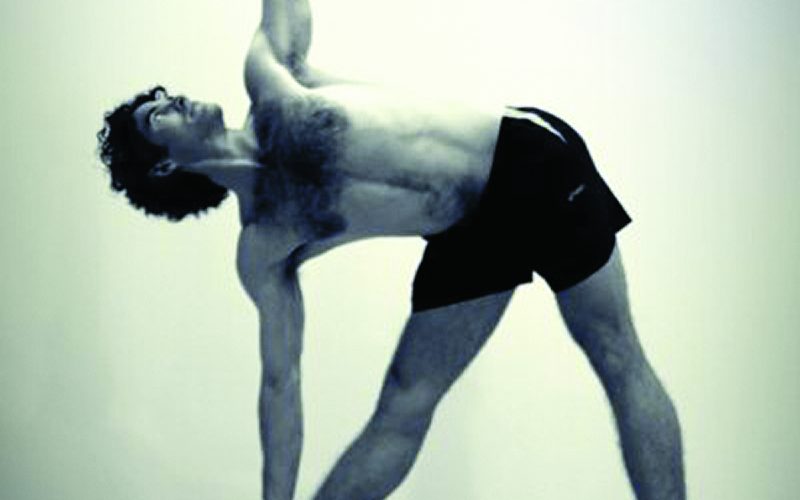Utthita Triknonasana
(oo-TEE-tah trik-cone-AHS-anna)
Extended Triangle Pose
Utthita Trikonasana — Extended Triangle Pose — is a personal favorite of mine. The triangle is one of the most rudimentary yet profound symbols, and there’s something mystical about aligning, both physically and mentally, with this simplest of spatial shapes. Enjoy linking in with your own sacred geometry.
1. From Tadasana (Mountain Pose) step or jump the feet 3-to-4 feet apart, keeping the heels aligned with one another.
2. Extend both arms away from the body, parallel to the floor. Lengthen through the fingertips while drawing the upper arms into their sockets. Allow the shoulders to roll away from the ears and down the back towards the waist while firming the shoulder blades forward through towards the front of the body, providing a relaxed lift to the heart center.
3. Rotate the right foot 90 degrees so that the outside of the foot runs parallel to the edge of the mat. Slightly rotate the back left foot inward, microbending both knees. Root both feet into the floor, acquiring even weight distribution through three foot locks, or bandhas: the center of each heal, the ball of each foot behind the big toe and the ball of foot behind the pinky toe. Avoid grabbing the mat with thetoes
4. Outwardly rotate the right thigh so that the kneecap centers over the ankle. Likewise, rotate the left thigh outward, hugging the kneecap into the thigh while avoiding hyperextension. You’ll know you’re holding the position correctly when the glutes are firmly engaged but the cheeks aren’t clinched. Note: some traditions encourage an inward rotation of the back thigh. Experiment, by all means. Give both a try and see which feels best.
5. Inhale and lengthen evenly through both sides of the body, allowing space to be created in between the vertebrae. With the exhale begin to draw back through the right hip while pressing the right foot firmly into the floor. Root the left foot in the mat while drawing up and out through the left hip. Bend from the hip rather than the waist. Keep the torso in line with the vertical plane of the right leg as you fold.
6. Continue to lengthen the spine, extending through the crown of the head. Listen to the hips and hamstrings — they’ll tell you when to stop bending. Rest the right hand on the thigh, shin or ankle, on a block/book, or on the floor. Regardless of placement, allow the hand to be a reference rather than a weight bearing hand. Leverage the pose by engaging throughout the core and maintaining a solid foundation in the lower body.
7. Reach the left hand towards the sky, bringing the left arm perpendicular to the floor and in line with the shoulder. Continue to press the shoulder blades forward through the front of the body while rolling the shoulders away from the ears. Keep your head neutral or turn and gaze toward the left hand.
8. Come out of the pose with an inhale, lengthening as you move. Return to center and switch it out. Sattva — balanced and harmonious living — is one of the jewels of a yoga practice. Balance the intensity and duration of asymmetrical poses for optimal well-being.
Practice playfully yet mindfully, questioning everything and integrating only that which aligns with your own experience. Consider discernment in place of judgement. While exercising the body, exercise the will. Listen internally and trust your intuition. And breath. Always breath.
Peace.
Alexander Wayne teaches yoga and meditation at the U of A and Fiddlehead Fern Therapeutics in Fayetteville. Check out 8 Days a Week for class schedule.



